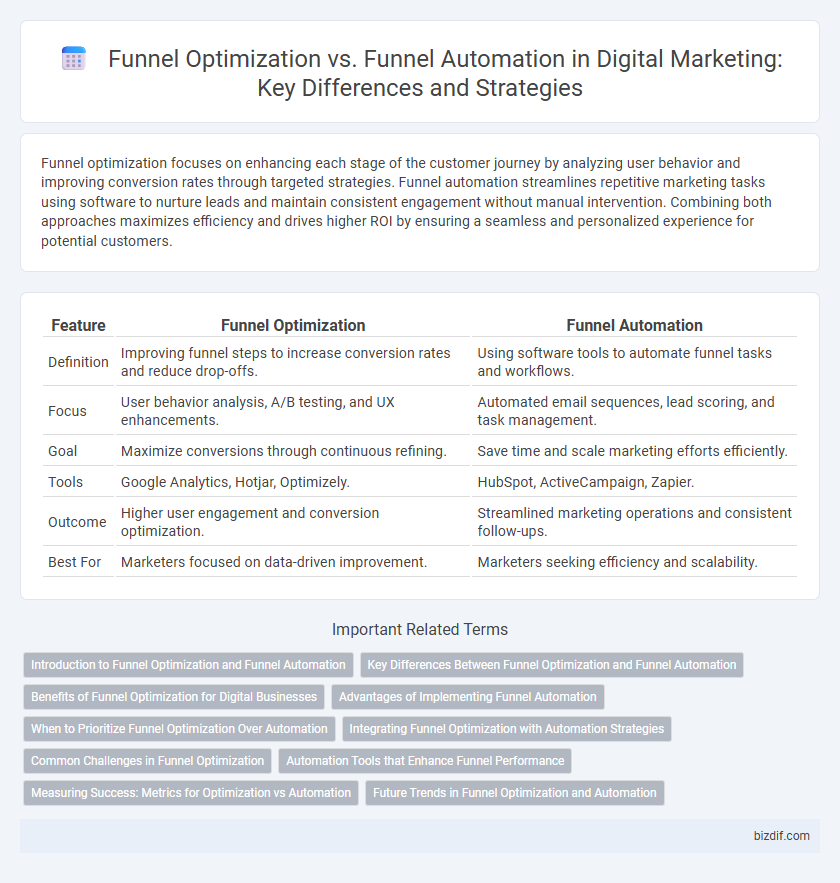Funnel optimization focuses on enhancing each stage of the customer journey by analyzing user behavior and improving conversion rates through targeted strategies. Funnel automation streamlines repetitive marketing tasks using software to nurture leads and maintain consistent engagement without manual intervention. Combining both approaches maximizes efficiency and drives higher ROI by ensuring a seamless and personalized experience for potential customers.
Table of Comparison
| Feature | Funnel Optimization | Funnel Automation |
|---|---|---|
| Definition | Improving funnel steps to increase conversion rates and reduce drop-offs. | Using software tools to automate funnel tasks and workflows. |
| Focus | User behavior analysis, A/B testing, and UX enhancements. | Automated email sequences, lead scoring, and task management. |
| Goal | Maximize conversions through continuous refining. | Save time and scale marketing efforts efficiently. |
| Tools | Google Analytics, Hotjar, Optimizely. | HubSpot, ActiveCampaign, Zapier. |
| Outcome | Higher user engagement and conversion optimization. | Streamlined marketing operations and consistent follow-ups. |
| Best For | Marketers focused on data-driven improvement. | Marketers seeking efficiency and scalability. |
Introduction to Funnel Optimization and Funnel Automation
Funnel optimization involves analyzing and improving each stage of the marketing funnel to increase conversion rates and enhance user experience, using data-driven insights and A/B testing. Funnel automation leverages software tools to automate repetitive tasks, such as lead nurturing and follow-ups, streamlining the customer journey and saving time. Both strategies aim to maximize marketing efficiency but differ in approach: optimization focuses on refining processes, while automation emphasizes systematizing workflows.
Key Differences Between Funnel Optimization and Funnel Automation
Funnel optimization focuses on improving each stage of the marketing funnel by analyzing user behavior, increasing conversion rates, and reducing drop-offs through A/B testing and targeted content adjustments. Funnel automation streamlines repetitive tasks such as email marketing, lead nurturing, and follow-ups using software tools to enhance efficiency and maintain consistent communication with prospects. The key difference lies in optimization enhancing performance through data-driven improvements, while automation prioritizes operational efficiency and scalability through technology.
Benefits of Funnel Optimization for Digital Businesses
Funnel optimization enhances digital marketing efficiency by increasing conversion rates through targeted analysis and refinement of each stage in the customer journey. By identifying drop-off points and improving user experience, digital businesses can significantly boost lead generation and sales performance. Optimized funnels provide actionable insights that reduce acquisition costs while maximizing ROI in competitive online markets.
Advantages of Implementing Funnel Automation
Funnel automation streamlines the customer journey by automatically guiding leads through targeted touchpoints, significantly reducing manual effort and human error. By integrating tools like email marketing platforms, CRM systems, and behavior-triggered workflows, businesses can deliver personalized content at scale, boosting conversion rates and customer retention. Real-time data tracking and automated nurturing enable faster decision-making and enhanced ROI compared to traditional funnel optimization methods.
When to Prioritize Funnel Optimization Over Automation
Prioritize funnel optimization over automation when conversion rates are low or customer drop-off is high, indicating that the user journey requires refinement for clarity and value delivery. Funnel optimization focuses on improving the effectiveness of each stage, testing variables such as messaging, design, and call-to-actions to maximize engagement and sales. Automation is most effective only after optimization ensures the funnel is efficient, as it scales proven processes rather than amplifying inefficiencies.
Integrating Funnel Optimization with Automation Strategies
Integrating funnel optimization with automation strategies enhances lead nurturing by combining data-driven insights with real-time personalized outreach, resulting in higher conversion rates. Funnel optimization focuses on analyzing user behavior to identify drop-off points, while automation streamlines follow-up processes like email sequences and retargeting ads. This synergy maximizes efficiency and scales marketing efforts by continuously refining the funnel based on automated feedback loops.
Common Challenges in Funnel Optimization
Funnel optimization faces common challenges such as identifying precise drop-off points, aligning content with customer intent, and effectively segmenting audiences for personalized experiences. Data integration issues and inconsistent tracking often hinder accurate performance analysis, limiting the ability to make informed adjustments. Overcoming these obstacles requires robust analytics tools and continuous testing to enhance conversion rates and overall funnel efficiency.
Automation Tools that Enhance Funnel Performance
Funnel automation tools such as HubSpot, ActiveCampaign, and ClickFunnels streamline lead nurturing by automating email sequences, segmentation, and customer follow-ups, significantly boosting conversion rates. These platforms integrate CRM systems and behavior tracking to deliver personalized experiences, reducing manual workload while maximizing funnel efficiency. Automation enhances real-time data analysis, enabling marketers to quickly adjust strategies and optimize performance at each funnel stage.
Measuring Success: Metrics for Optimization vs Automation
Funnel optimization measures success through conversion rate, bounce rate, and average session duration, focusing on refining user experience and increasing engagement at each stage of the marketing funnel. Funnel automation tracks metrics like lead velocity rate, email open rates, and campaign response rates to evaluate the efficiency and scalability of automated workflows. Analyzing these data points helps marketers pinpoint areas for improvement in both manual adjustments and automated processes, driving overall digital marketing performance.
Future Trends in Funnel Optimization and Automation
Future trends in funnel optimization emphasize AI-driven personalization and real-time data analytics to enhance customer journey efficiency. Funnel automation increasingly leverages machine learning algorithms and advanced CRM integrations to streamline lead nurturing and improve conversion rates. Businesses adopting predictive analytics and dynamic content delivery in their funnels are poised to outperform competitors by delivering tailored user experiences at scale.
Funnel optimization vs Funnel automation Infographic

 bizdif.com
bizdif.com